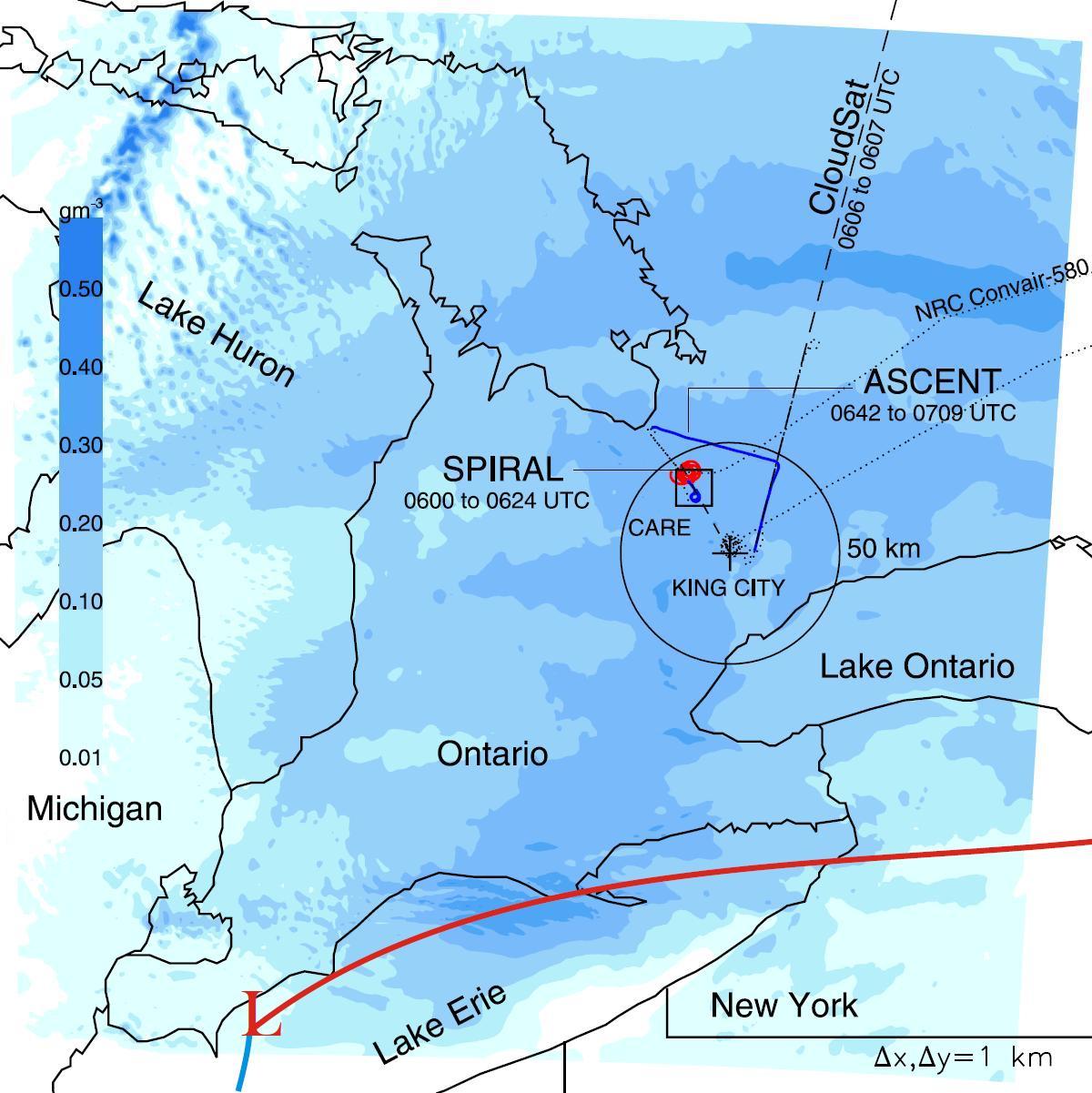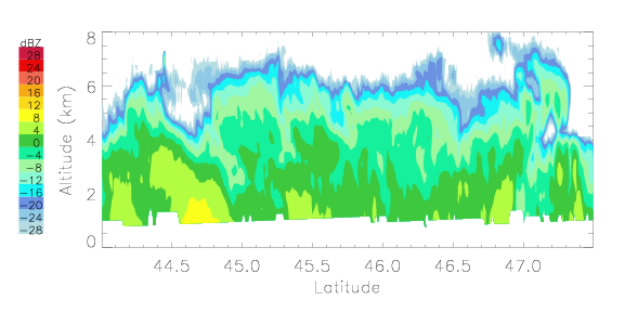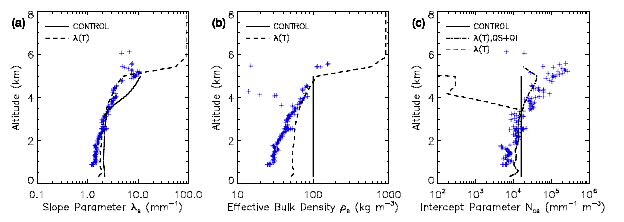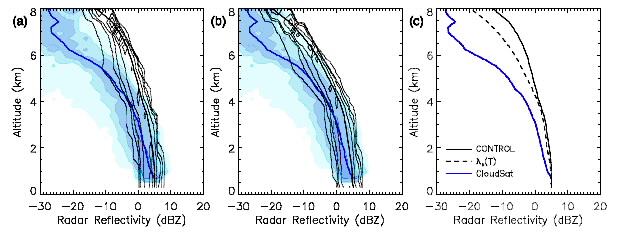WRF Microphysical Adjustments with CloudSat
On the time and space scales of regional weather, accurate forecasts of cloud cover are required to predict the diurnal temperature cycle and likelihood of precipitation. Clouds and precipitation disrupt transportation networks, and in severe cases, may contribute to flooding, property damage or agricultural losses. Many of these problems may be alleviated through risk mitigation strategies, enhanced by accurate weather forecasts issued in the form of watches and advisories. Numerical models assist with the issuance of these operational forecast products. Gains in forecasting will come from improved simulation of clouds and their microphysical processes, achieved through steady increases in computer resources and forecast models that operate at cloud resolving resolution, rather than current convective parameterization schemes. Accurate short-term weather forecasts have a demonstrable benefit to society, but will also translate to the improved simulation of present and future climate, as global models transition to the use of cloud-resolving models in the form of superparameterizations. Improving cloud processes in operational, daily weather forecasts will translate to greater forecast skill on relatively short time periods, a primary goal of the SPoRT Center.
The NASA CloudSat 94 GHz Cloud Profiling Radar was launched, as a member of the A-Train of Earth Observing Satellites, in order to obtain vertical profiles of cloud layers and properties and builds on the robust heritage of ground-based 94 GHz profiling systems (Stephens et al. 2002). Data from CloudSat may be used to compare the properties of real clouds to their counterparts, as simulated within a numerical model. Although cloud resolving models offer a wide range of microphysics packages, CloudSat is currently being used to evaluate the performance of the Goddard six-class, single-moment microphysics scheme (Tao et al. 2008) as implemented within the Weather Research and Forecasting (WRF) Model. Due to the operating frequency of the CloudSat radar, the focus of current work is on cold-season, midlatitude cyclones producing light to moderate snowfall. Forecasts of these systems are not as dependent upon mesoscale processes and are well observed by synoptic-scale observation networks within the continental United States. These cyclones produce cloud cover and precipitation over multiple states, often leading to difficult forecasts for these high impact events. Within the WRF model, forecasts of precipitation and type depend upon the correct evolution and distribution of water mass among various hydrometeor classes. Meanwhile, forecasts of surface and profile temperatures depend upon diabatic processes in the form of latent heat exchange and the interaction of solar and terrestrial radiation with the modeled cloud shield.
 Figure 1. Snow content at the lowest altitude model vertical level, valid at 0600 UTC on 22 January 2007, based
upon initial and boundary conditions from the NCEP GFS model and the NASA Goddard single-moment microphysics
scheme. Location of C3VP campaign assets are indicated: the Canadian Center for Atmospheric Research Experiments
(CARE), the King City radar, the CloudSat flight track, and the flight track of the NRC Convair-580 aircraft.
Aircraft data segments used here are indicated as the descending spiral and departure ascent in the vicinity of
the King City radar.
Figure 1. Snow content at the lowest altitude model vertical level, valid at 0600 UTC on 22 January 2007, based
upon initial and boundary conditions from the NCEP GFS model and the NASA Goddard single-moment microphysics
scheme. Location of C3VP campaign assets are indicated: the Canadian Center for Atmospheric Research Experiments
(CARE), the King City radar, the CloudSat flight track, and the flight track of the NRC Convair-580 aircraft.
Aircraft data segments used here are indicated as the descending spiral and departure ascent in the vicinity of
the King City radar.
Field campaigns offer the best opportunity to evaluate the assumptions within the microphysics schemes available to the WRF model. The Canadian CloudSat/CALIPSO Validation Project (C3VP, Figure 1) was a multinational, collaborative effort to provide a suite of observations necessary for the validation and improvement of cloud resolving models, precipitation estimation and satellite retrievals (Hudak et al. 2006). Efforts were spearheaded at the Canadian Centre for Atmospheric Research Experiments (CARE) site in southeastern Ontario, where surface instrumentation provided validation of precipitation and temperature, measurement of snow crystal size distributions, crystal fall speeds, and radars. The C3VP campaign included an instrumented aircraft, capable of measuring size distributions and their vertical variability, which in turn provided vertical profiles of size distribution and bulk density for comparison to model assumptions. On 22 January 2007, an extratropical cyclone produced a widespread area of moderate to heavy snowfall across the C3VP observational domain. The event was reconstructed with the WRF model and NASA Goddard single-moment microphysics scheme, which combined to produce a reasonable depiction of the weather observed during the storm. By reproducing the event, the WRF simulation provides an opportunity to compare model assumptions against observations provided by C3VP campaign data. In addition, the availability of CloudSat radar reflectivity (Figure 2) allows for a comparison between the reflectivity characteristics of simulated and observed precipitation structures.
 Figure 2. CloudSat 94 GHz Cloud Profiling Radar reflectivity (dBZ) for the flight track segment in Figure 1,
depicting the structure of snowfall occurring across the C3VP campaign at 0600 UTC, 22 January 2007.
Figure 2. CloudSat 94 GHz Cloud Profiling Radar reflectivity (dBZ) for the flight track segment in Figure 1,
depicting the structure of snowfall occurring across the C3VP campaign at 0600 UTC, 22 January 2007.
The current version of the NASA Goddard single-moment scheme makes a few assumptions regarding the properties of simulated snow crystals: that the size distribution is exponential with a fixed intercept, that the bulk density of crystals is constant, and that crystal shapes are best approximated by spheres. These assumptions result in a calculation of the distribution slope parameter, based upon conservation of the snow mass predicted by simulated microphysical processes. When constants are utilized, the resulting distribution slope parameter is nearly invariant, while aircraft data suggest that the slope increases with height. This increase with height corresponds to a decrease in mean crystal size, whereas the NASA Goddard scheme maintains a similar mean size throughout the lowest 2-3 km of simulated snowfall (Figure 3a). The use of a fixed density fails to represent the decrease in bulk density of crystals as they form aggregates between cloud top and cloud base (Figure 3b). Finally, a fixed distribution intercept fails to represent the orders of magnitude increase that is observed in C3VP aircraft data (Figure 3c). Therefore, these fixed value approaches fail to represent the natural variability observed from aircraft data. SPoRT has explored the development of temperature-based parameterizations for values that are currently assigned as constants and found that this approach had merit, although success is limited in this warm frontal overrunning event where the vertical profile of temperature is nearly isothermal or complicated by shallow inversions. In temperature-dependent functions, an isothermal profile will still produce a vertical profile with limited variability.
 Figure 3. (a) Vertical profile of the snow crystal distribution slope parameter from the NASA Goddard
forecast, compared to an approach using a temperature-based parameterization. (b) As in (a) but for the
snow bulk density. (c) As in (a) but for the intercept parameter of the snow crystal size distribution.
Figure 3. (a) Vertical profile of the snow crystal distribution slope parameter from the NASA Goddard
forecast, compared to an approach using a temperature-based parameterization. (b) As in (a) but for the
snow bulk density. (c) As in (a) but for the intercept parameter of the snow crystal size distribution.
Shape assumptions are relevant to comparisons between CloudSat reflectivity and simulated reflectivity obtained from WRF model output. Single scattering characteristics of spheres and naturally occurring crystal shapes differ significantly (Liu 2004, Liu 2008), while snow aggregates present unique challenges (Ishimoto 2008). Through simulation of CloudSat reflectivity from Ishimoto (2008) aggregates, it was determined that nonspherical shape assumptions are required in order to represent an appropriate lapse rate for reflectivity. Simulation of aggregates by equivalent diameter, Mie scattering spheres may suffer from Mie resonance effects and limit the ability to obtain a steady, downward increase in 94 GHz reflectivity from large aggregates that are represented by equivalent diameter spheres. Median profiles of reflectivity from aggregates are capable of representing the general shape of the median CloudSat profile, but success in the lowest 2 km is limited by the poor representation of mean crystal size provided by the NASA Goddard scheme or temperature-dependent parameterizations, which struggle to represent vertical variability in the presence of a nearly isothermal temperature profile.
 Figure 4. Simulation of CloudSat 94 GHz reflectivity based upon aggregate shapes and predictions from the
(a) NASA Goddard or (b) experimental, temperature-dependent parameterizations. Reflectivity
comparisons are provided as contoured frequency with altitude diagrams (CFADs, Yuter and Houze 1995), or
probability distributions of reflectivity along fixed altitude intervals. Contours are at intervals of 1, 5, 10,
25 and 50% with CloudSat values shaded. (c) Median profiles of CloudSat and WRF-simulated reflectivity.
Figure 4. Simulation of CloudSat 94 GHz reflectivity based upon aggregate shapes and predictions from the
(a) NASA Goddard or (b) experimental, temperature-dependent parameterizations. Reflectivity
comparisons are provided as contoured frequency with altitude diagrams (CFADs, Yuter and Houze 1995), or
probability distributions of reflectivity along fixed altitude intervals. Contours are at intervals of 1, 5, 10,
25 and 50% with CloudSat values shaded. (c) Median profiles of CloudSat and WRF-simulated reflectivity.
This initial investigation has demonstrated the limitations of a fixed-value approach when characterizing the properties of simulated snowfall, and continuing efforts within SPoRT will look for ways to incorporate non-spherical shape assumptions within the NASA Goddard single-moment scheme while parameterizing size distribution characteristics as functions of variables that represent the vertical variability of aggregates observed in nature. Additional C3VP cases will be explored, emphasizing other synoptic-scale snowfall events, or differences between synoptic-scale storms and lake effect cases.
References Cited
- Stephens, G.L., D.G. Vane, R.J. Boain, G.G. Mace, K. Sassen, Z. Wang, A.J. Illingworth, E.J. O'Connor, W.B. Rossow, S.L. Durden, S.D. Miller, R.T. Austin, A. Benedetti, C. Mitrescu, and T. CloudSat Science Team, 2002: The CloudSat Mission and the A-Train. Bulletin of the American Meteorological Soc., 83, 1771-1790. (abstract online)

